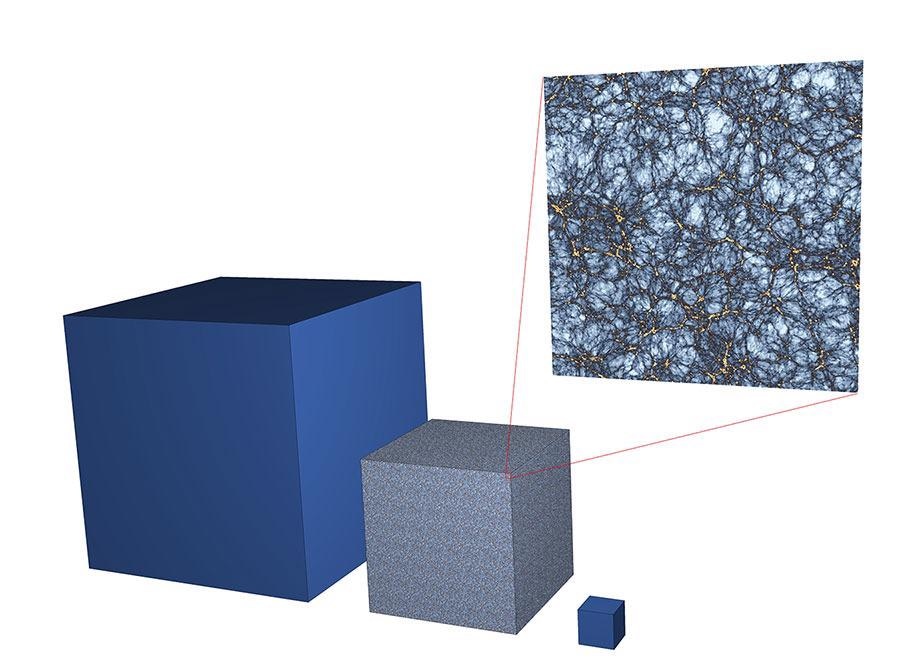Mar 19 2021
Two groups of American astronomers have played a guess-the-numbers game with cosmological implications. They used a mock catalog of galaxies created by a Japanese group to accurately guess the cosmological parameters employed to produce the catalog within an accuracy of 1%.
 The volume of the challenge data prepared by the Japanese team (center), compared to the total volume of the real Universe observable by light (left), and the volume of one of the largest galaxy survey catalogs, the Sloan Digital Sky Survey (right). From left to right, the volumes would be equivalent to cubes with edges of 75 billion light-years, 40 billion light-years, and 9 billion light-years. The marbling in the simulation shows areas of high (red) and low (blue) density. Image Credit: Takahiro Nishimichi.
The volume of the challenge data prepared by the Japanese team (center), compared to the total volume of the real Universe observable by light (left), and the volume of one of the largest galaxy survey catalogs, the Sloan Digital Sky Survey (right). From left to right, the volumes would be equivalent to cubes with edges of 75 billion light-years, 40 billion light-years, and 9 billion light-years. The marbling in the simulation shows areas of high (red) and low (blue) density. Image Credit: Takahiro Nishimichi.
Thus, researchers can be confident that their technique could help identify the right parameters of the real Universe upon being applied to observational data.
The fundamental equations on which the evolution of the Universe is based can be derived from theoretical calculations. However, certain numbers in those equations, or the cosmological parameters, can be derived only by making observations.
Cosmological parameters associated with the parts of the Universe that cannot be observed, such as the expansion of the Universe or the amount of dark matter powered by dark energy, must be deduced by analyzing their effects on the distribution of visible galaxies.
When working with the dark part of the Universe, there is always uncertainty and it is difficult to be certain that the data analysis and models are correct.
A team of Japanese researchers headed by Takahiro Nishimichi at Kyoto University and the Kavli IPMU(note) at the University of Tokyo tested the data analysis by using the ATERUI II supercomputer at the National Astronomical Observatory of Japan to develop 10 mock universes with a total volume that is 100 times greater than even the most comprehensive galaxy surveys to date.
The high resolution, large volume, and large dynamical range that can be achieved only with the most powerful supercomputer in the world devoted to astronomy were required to isolate systematic errors in the analysis models from random errors because of pointless coincidences in the data.
The cosmological parameters that helped develop these mock universes were randomly selected from the array of reasonably predicted values. The Japanese researchers created a catalog including a list of positions of the galaxies in the simulation analogous to the catalogs made by real telescopes observing the heavens.
Then, the Japanese researchers challenged other astronomers to guess the numbers used to prepare the catalog.
The challenge was accepted by two teams of American astronomers. Both teams worked independently and used different techniques to analyze the Japanese data by using tools employed for real astronomy surveys.
Each team was given only one chance to guess the numbers, and both of them generated answers within 1% of the real values. This indicates that these techniques should offer accurate results if applied to real observational data.
The correct numbers have still been kept as a secret so that more researchers can play guess-the-numbers. Thus, the challenge data will continue to help develop and test cosmic analysis techniques.
Journal Reference:
Nishimichi, T., et al. (2020) Blinded challenge for precision cosmology with large-scale structure: Results from effective field theory for the redshift-space galaxy power spectrum. Physical Review D. doi.org/10.1103/PhysRevD.102.123541.